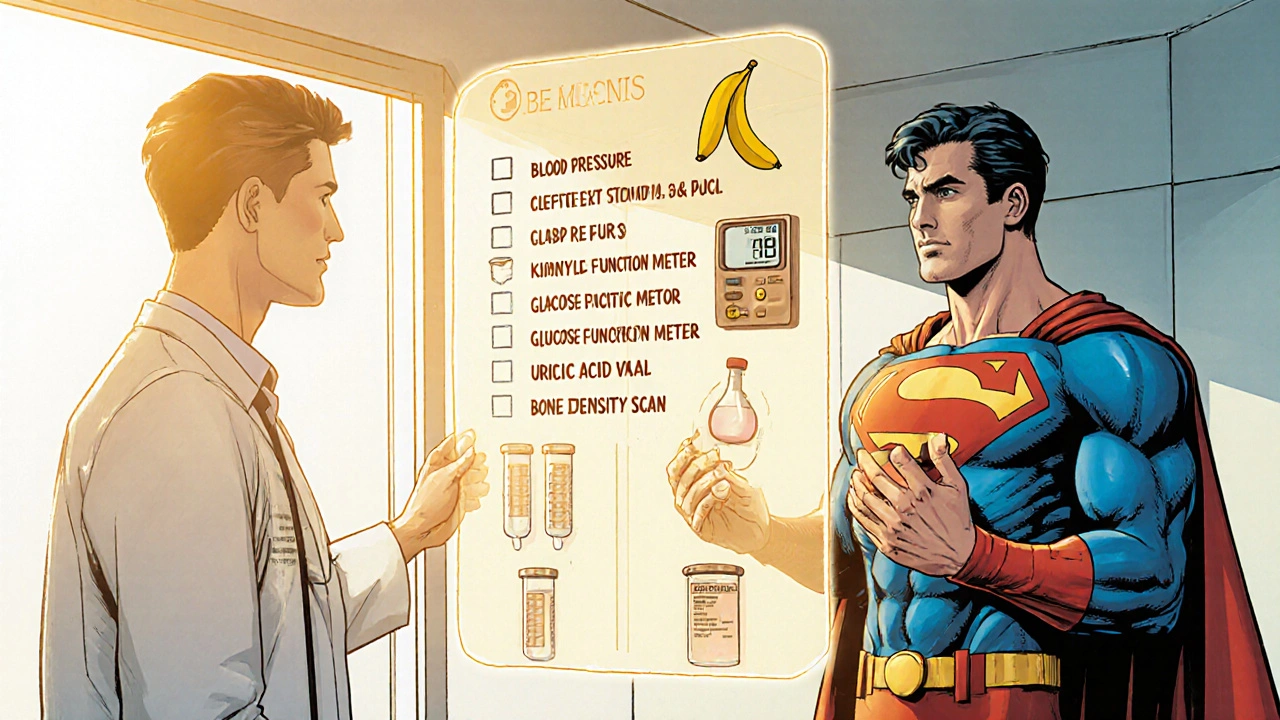Chlorthalidone Lab Monitoring Checker
This tool checks if your lab results fall within recommended ranges for people taking chlorthalidone long-term. Based on guidelines from the article, enter your values below to see if your results are safe or if you should consult your doctor.
Enter your lab values above to see results.
Monitoring Recommendations
Based on the article:
- Potassium, Magnesium, Sodium, Calcium Every 3-6 months
- Renal Function (creatinine, eGFR) At least twice yearly
- Fasting Glucose & HbA1c Yearly (more if risk factors)
- Uric Acid Level Annually if gout history
People taking chlorthalidone for months or years often wonder what might happen to their bodies over time. This guide breaks down the science, the risks, and the practical steps you can take to stay healthy while on this common blood‑pressure medication.
How Chlorthalidone Works
Chlorthalidone is a thiazide‑like diuretic that helps the kidneys remove excess sodium and water. By reducing fluid volume, it lowers blood pressure and eases swelling (edema). The drug also opens up blood vessels, giving the heart an easier time pumping blood.
Short‑Term vs. Long‑Term Effects
In the first few weeks, users might notice increased urination, mild dizziness, or a slight drop in potassium levels. These are usually easy to manage and often fade as the body adjusts. The real question is what happens when the medication is taken for years.
Cardiovascular Outcomes Over Time
Long‑term use of Hypertension-treating diuretics has been linked to a modest reduction in heart attacks and strokes, especially when combined with other blood‑pressure drugs. However, the benefit can be offset if electrolyte imbalances develop, because low potassium can trigger arrhythmias.
Electrolyte Disturbances
One of the most common chronic concerns is Electrolyte imbalance. Over months, chlorthalidone can deplete potassium, magnesium, and calcium while raising sodium. Persistent low potassium (< 3.5mmol/L) may cause muscle cramps, fatigue, and in severe cases, life‑threatening heart rhythm problems.
Kidney Function and Long‑Term Use
Kidney health is another key area. Studies tracking patients for five years or more show that, for most, the drug does not accelerate chronic kidney disease (CKD). In fact, better blood‑pressure control can slow CKD progression. Yet, a small subset develops reduced glomerular filtration rate (GFR) because the kidney’s ability to concentrate urine weakens.

Metabolic Effects: Blood Sugar and Lipids
Long‑term chlorthalidone may raise fasting glucose modestly-about 1-2mg/dL on average. This can be a tipping point for people already on the edge of pre‑diabetes. Lipid profiles may also shift, with slight increases in LDL cholesterol and triglycerides. The changes are usually small, but they matter for patients with existing metabolic syndrome.
Uric Acid and Gout Risk
The drug reduces the kidneys’ ability to excrete uric acid, leading to higher serum levels. Over years, this elevates the risk of gout attacks. For a patient with a history of gout, doctors often choose an alternative diuretic or add a urate‑lowering medication.
Bone Health Considerations
Calcium loss through the urine can affect bone mineral density (BMD). Longitudinal studies spanning a decade suggest a slight increase in fracture risk, especially in post‑menopausal women. Combining chlorthalidone with calcium supplementation and weight‑bearing exercise can mitigate the effect.
Monitoring Recommendations
Because the long‑term picture is nuanced, regular monitoring is essential. Here’s a practical checklist you can discuss with your clinician:
- Blood pressure check every 1-2months during dose adjustments, then at least quarterly.
- Serum electrolytes (potassium, magnesium, sodium, calcium) every 3-6months.
- Renal function (serum creatinine, eGFR) at least twice a year.
- Fasting glucose and HbA1c yearly, or more often if you have risk factors.
- Uric acid level annually if you’ve had gout.
- Bone density scan (DXA) every 2-3years for those over 60 or with osteoporosis risk.

Managing Side Effects If They Arise
If blood tests show low potassium, your doctor might add a potassium‑sparing diuretic (like spironolactone) or recommend dietary sources-bananas, potatoes, and leafy greens. For elevated uric acid, lifestyle tweaks (limiting red meat and alcohol) and medications such as allopurinol are options.
Comparing Common and Rare Long‑Term Effects
| Effect | Frequency | Typical Onset |
|---|---|---|
| Potassium depletion | Common | 3-6 months |
| Elevated uric acid / gout | Common | 6-12 months |
| Reduced eGFR | Uncommon | 1-3 years |
| Increased fasting glucose | Uncommon | 1-2 years |
| Bone density loss | Rare | 5+ years |
| Severe arrhythmia due to hypokalemia | Rare | Variable |
Bottom Line: Stay Informed and Proactive
Chlorthalidone remains a cost‑effective, evidence‑based choice for controlling blood pressure. The key to reaping its benefits while limiting long‑term drawbacks is regular lab work, a balanced diet, and open communication with your healthcare team.
Frequently Asked Questions
Can I take chlorthalidone forever?
Many patients stay on chlorthalidone for years, even decades, as long as labs stay stable and blood pressure remains controlled. Ongoing monitoring is essential.
What are the signs of dangerous potassium loss?
Weakness, muscle cramps, constipation, and irregular heartbeats are warning signs. If you notice any, contact your doctor promptly.
Is chlorthalidone safe for people with diabetes?
It can be used, but doctors watch glucose levels closely because the drug may raise fasting glucose slightly. Lifestyle measures and occasional medication tweaks keep it in check.
How often should I get blood tests while on this medication?
Initially every 3months for electrolytes and kidney function, then every 6-12months if results stay stable.
Can diet reduce the risk of side effects?
Yes. A diet rich in potassium (bananas, oranges), low in sodium, limited red meat and alcohol, plus adequate calcium and vitaminD, helps counteract many of the long‑term risks.
Seth Angel Chi
October 16, 2025 AT 16:57Chlorthalidone is overprescribed, and its chronic electrolyte drain is rarely acknowledged.
Kristen Ariies
October 23, 2025 AT 15:37Wow, what a thorough breakdown! Your guide shines a bright light on hidden risks, and it empowers readers to take charge of their health, which is absolutely fantastic! Keep spreading this knowledge, because every extra bit of insight can save a life, and we all deserve that level of care!
Donny Bryant
October 30, 2025 AT 13:17I’ve been on chlorthalidone for a few years and keep an eye on my potassium levels. Regular blood work makes the side effects manageable.
kuldeep jangra
November 6, 2025 AT 11:57Managing a medication like chlorthalidone can feel overwhelming at first, but with the right approach it becomes a routine part of your health plan. First, schedule a baseline panel of electrolytes, kidney function, and glucose before you settle into a long‑term dosing schedule. Second, aim to incorporate potassium‑rich foods such as bananas, oranges, spinach, and sweet potatoes into every meal. Third, stay hydrated but avoid excessive fluid intake that could dilute electrolytes further. Fourth, set reminders for your quarterly blood pressure checks so you never miss a dose adjustment. Fifth, discuss with your physician the possibility of adding a potassium‑sparing diuretic if your labs drift low. Sixth, consider a low‑purine diet and limited alcohol to keep uric acid in check and reduce gout risk. Seventh, keep a simple log of your symptoms, noting any muscle cramps, fatigue, or irregular heartbeats immediately. Eighth, remember that exercise, especially weight‑bearing activities, supports bone density while you are on a thiazide‑like agent. Ninth, if you notice a gradual rise in fasting glucose, talk to your doctor about lifestyle tweaks or alternative therapies. Tenth, regular eye exams are advisable because blood pressure swings can affect retinal health. Eleventh, do not ignore subtle changes in urination patterns; they can hint at early kidney stress. Twelfth, share your medication list with any new healthcare provider to avoid drug interactions. Thirteenth, embrace community support groups where patients exchange tips on managing side effects. Fourteenth, stay positive; many people live decades on chlorthalidone without serious complications when monitored properly. Finally, always keep an open line of communication with your care team, because proactive adjustments are the cornerstone of long‑term safety.
harry wheeler
November 13, 2025 AT 10:37Chlorthalidone works well for blood pressure but watch electrolytes regularly.
faith long
November 20, 2025 AT 09:17Don’t be fooled by the hype that this cheap diuretic is harmless; the potassium loss can cripple your heart in weeks. If your doctor ignores low potassium, they are essentially courting arrhythmias. Push for a potassium‑sparing add‑on or switch drugs immediately. The gout risk is not a myth-it’s a well‑documented trigger that will ruin your joints. Stop tolerating fatigue and muscle cramps; they are warning signs, not minor annoyances. Demand regular labs every three months, not every six. If insurance hurdles block testing, fight them like your life depends on it, because it does. Your health is non‑negotiable, and no one should tell you otherwise.
Samantha Dean
November 27, 2025 AT 07:57From a philosophical standpoint, the ethical imperative of informed consent necessitates that patients understand both the benefits and the latent risks of chronic chlorthalidone therapy. The interplay between pharmacologic efficacy and physiological perturbation invites a nuanced discourse on medical responsibility. Accordingly, clinicians should present monitoring protocols as integral components of the therapeutic alliance. Such transparency fosters patient autonomy and aligns with the Hippocratic tradition of “do no harm.”
Vanessa Peters
December 4, 2025 AT 06:37The data presented in this guide lays bare a pattern of complacency that plagues modern prescribing habits. It’s alarming how the medical establishment normalizes electrolyte depletion as “just a side effect.” By glossing over the insidious rise in gout incidence, the narrative cushions corporate profit over patient well‑being. This selective emphasis is nothing short of intellectual malpractice. Readers deserve an unvarnished truth, not a sugar‑coated summary.
Suzan Graafstra
December 11, 2025 AT 05:17If we peel back the layers of biomedical jargon, we encounter a paradox: a drug that stabilizes pressure yet destabilizes mineral balance. Is this not a metaphor for the human condition, where equilibrium is constantly negotiated? The long‑term horizon forces us to confront the temporality of intervention. In that sense, chloroquine-sorry, chlorthalidone-becomes a mirror reflecting our own fragility.
Ralph Louis
December 18, 2025 AT 03:57Listen up, folks-popping a cheap diuretic every day without checking labs is like driving a sports car blindfolded. You’re courting disaster with every missed potassium check, and that’s just morally reckless. Get the tests, stay sharp, and own your health.